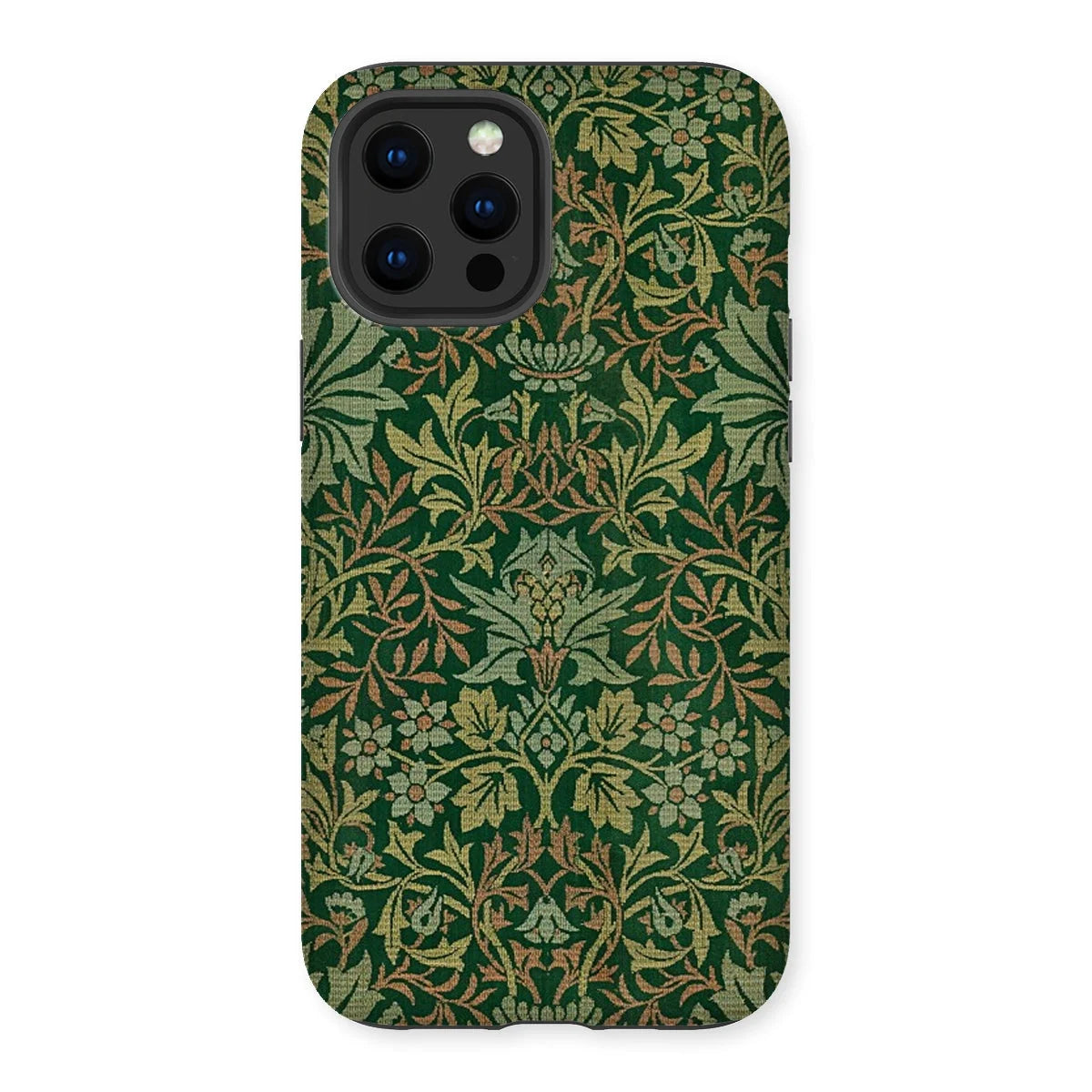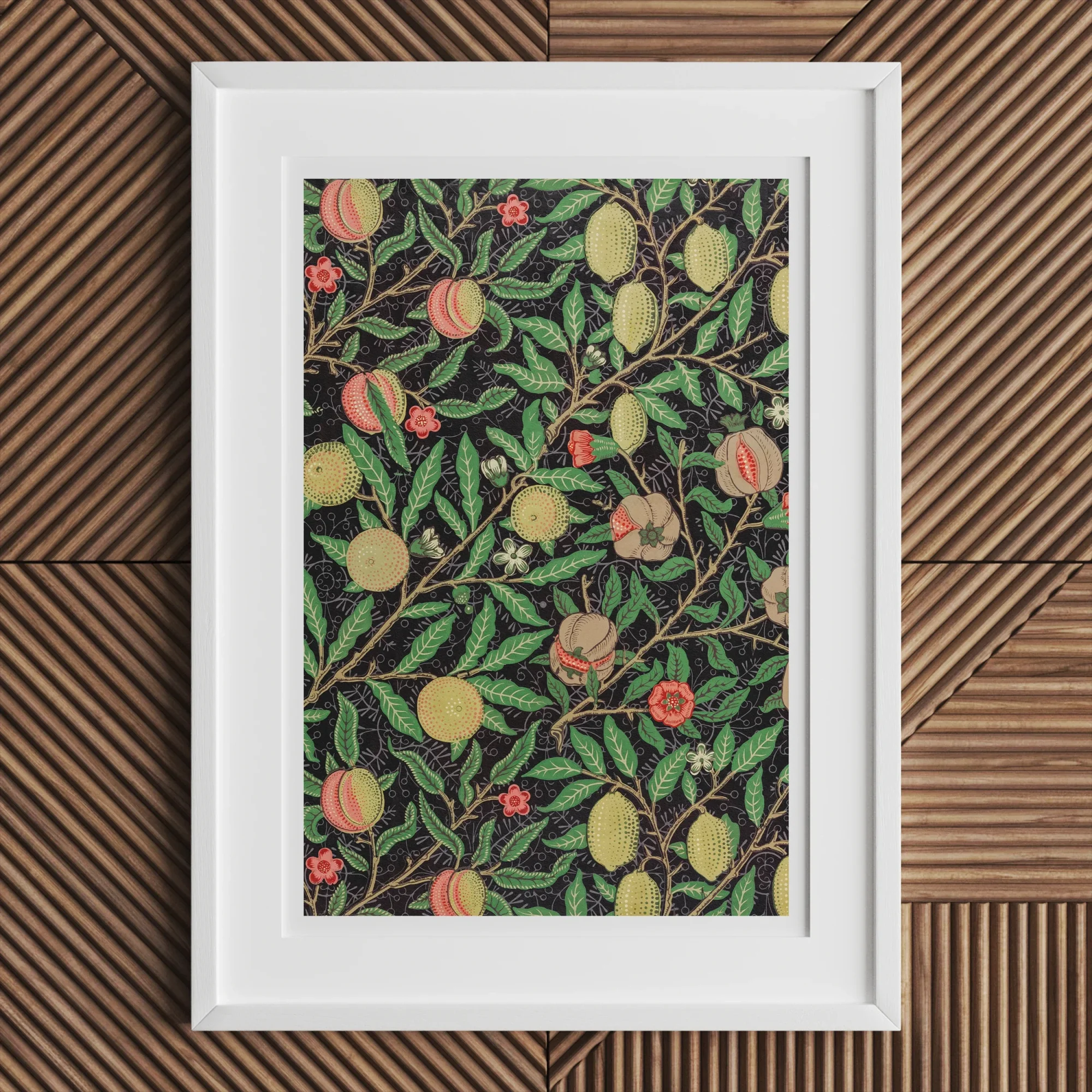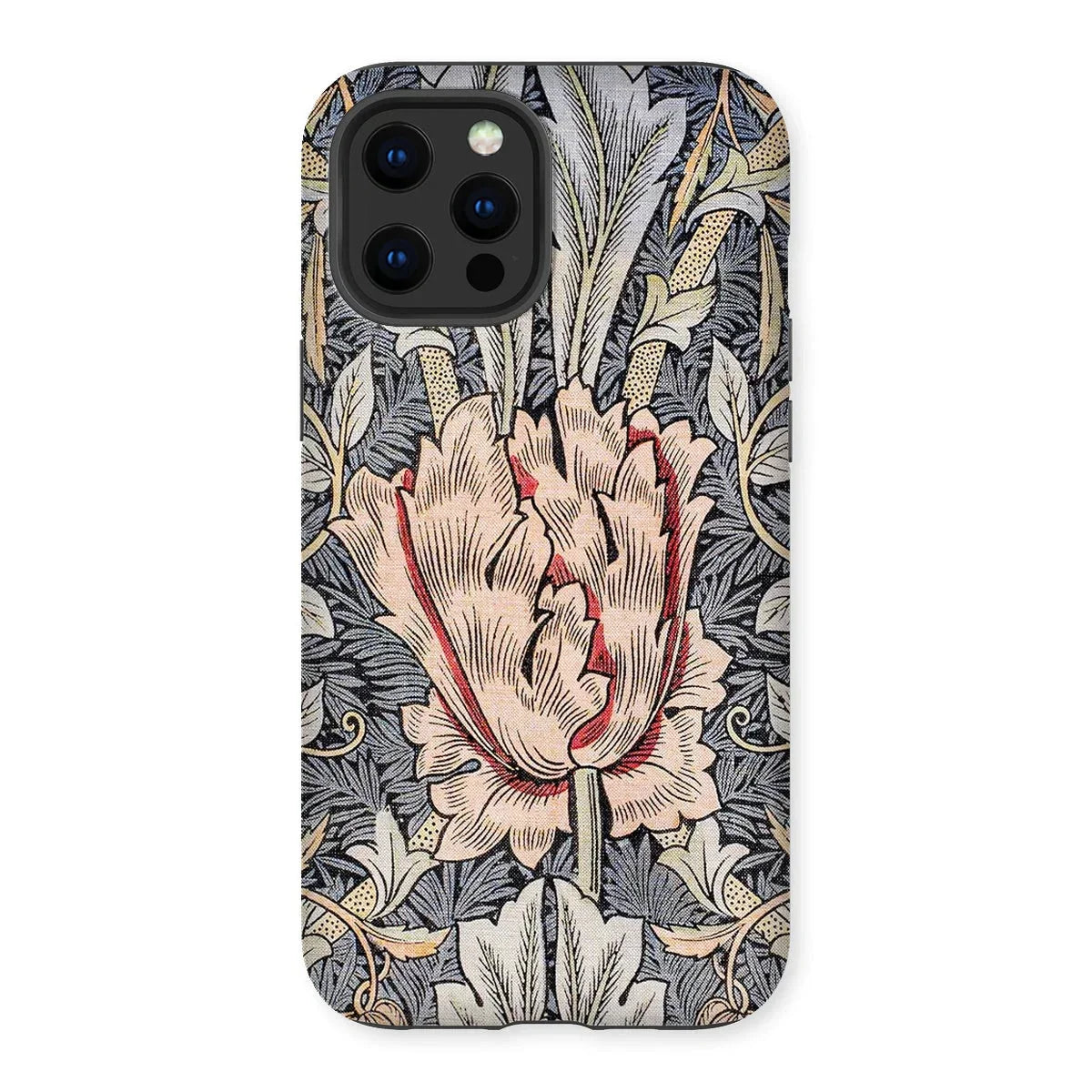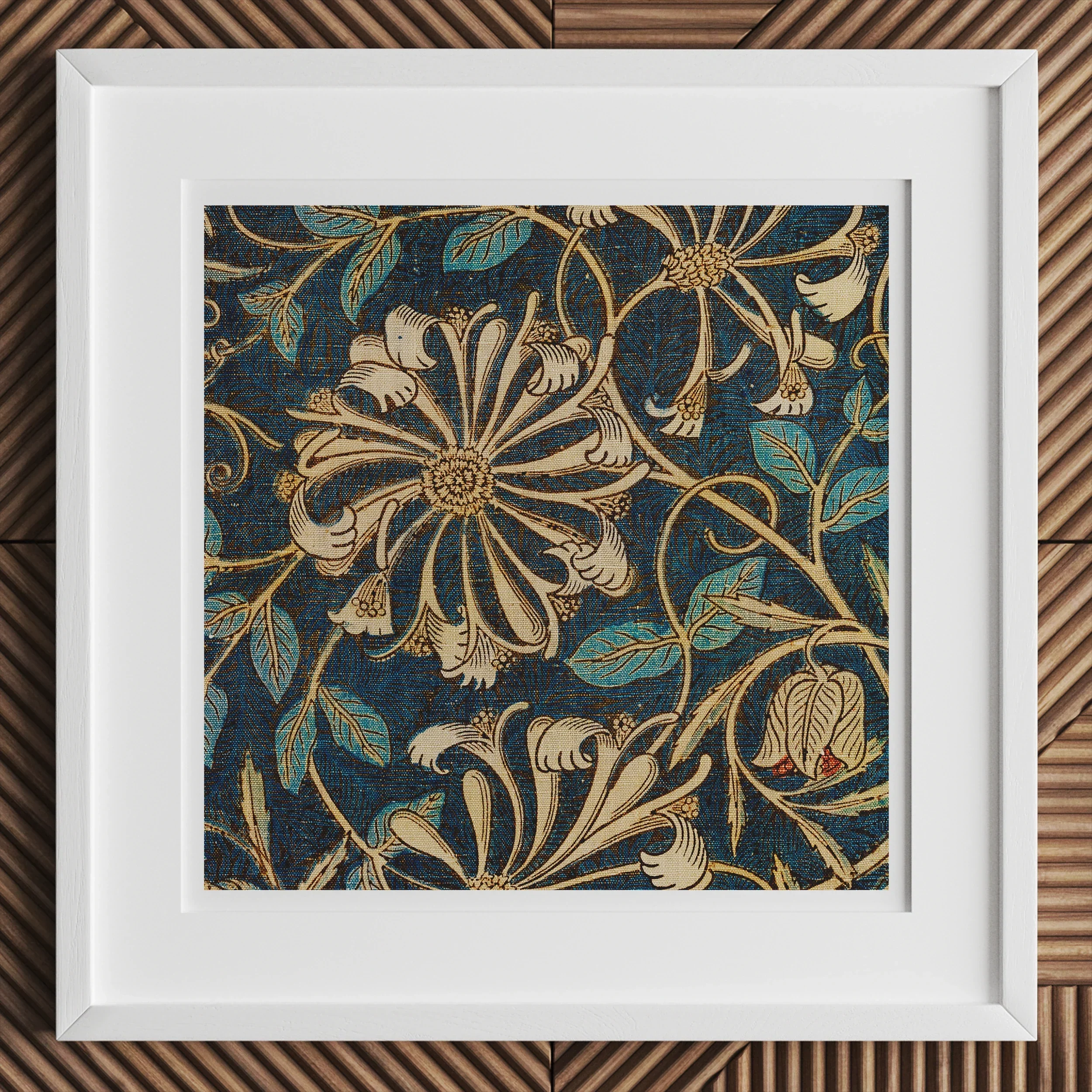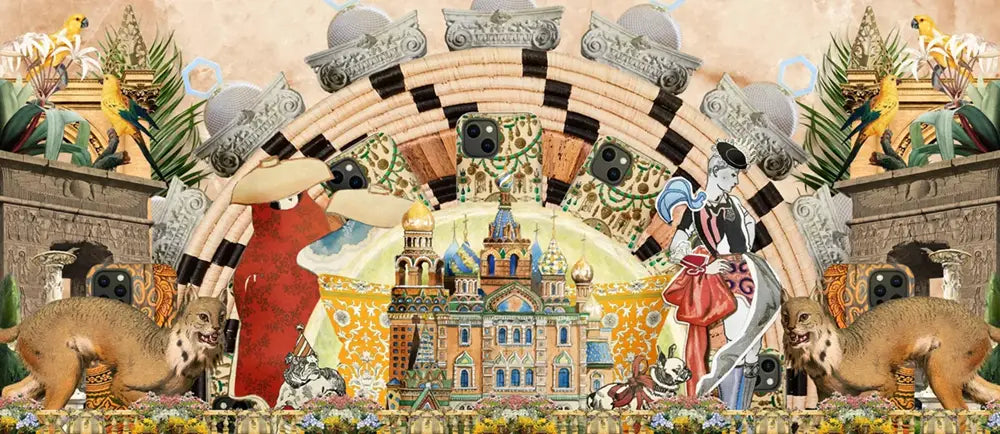In a summer dripping with heat and improbable dreams, 1860 slouched toward legend. At the edge of London — lion-maned and restless as a pagan god — William Morris climbed a ladder toward immortality. Red House, his strange, beautiful fortress of rebellion, was not built to shelter bodies; it was built to house a revolution, brick by defiant brick.
Sunlight slanted onto whitewashed walls aching for transformation. Soon, they would blaze with knights in armor and queens heavy with longing, painted by hands that trembled not with doubt but with fierce, joyous audacity. Below the ladder, Dante Gabriel Rossetti sprawled like a decadent prophet, slinging critiques as casually as a boy skips stones, heckling Morris’s depiction of Sir Lancelot and Queen Guenevere into sharper myth.
This was no domestic renovation. Red House was a manifesto disguised as architecture. Rossetti, ever the cynic, called it “more a poem than a house but admirable to live in too.” But Morris knew better: it was a siege engine, aimed squarely at the sallow face of Victorian industrial rot.
Here, comradeship took on the fevered glow of religious rite. The laughter was raucous, the paint splatters furious, the poetry half-mumbled through mouthfuls of ale and argument. Red House didn’t whisper its rebellion; it howled it through every carved lintel, every wild fresco of longing and defiance.
The Pre-Raphaelite Brotherhood, once a whispered mutiny against the ossified Royal Academy, had matured here into something rowdier, hungrier. Founded in 1848, the Brotherhood — Millais, Hunt, Rossetti, and their ardent fellows — had first declared their allegiance to truth and nature against the suffocating formulae of classical painting. But at Red House, that defiance thickened, bleeding into every corner of existence.
Morris and his allies didn’t merely want art in their lives; they wanted life as art, undivided, undiminished. Every hand-mixed pigment, every hand-forged nail, every tapestry-in-the-making was a refutation of the machine, the assembly line, the soul-draining world taking shape beyond their red brick Eden.
The mythology they painted wasn’t escapism. It was insurgency. By reaching backward — to Giotto’s clumsy saints and Fra Angelico’s trembling madonnas — they propelled themselves forward, insisting that sincerity, color, and craftsmanship could wrench a civilization back from its own industrial precipice.
Red House pulsed with that wild ambition. It was a living text, a breathing canvas, a proclamation: beauty was not to be sequestered behind velvet ropes in galleries. It belonged in the blood and breath of daily life — in the creak of a hand-carved chair, in the smear of blue pigment on a kitchen door.
And so, with laughter loud enough to crack the plaster, Morris and his conspirators declared a new kind of revolution: not one of guillotines or manifestos, but of hands at work and imaginations unchained. Red House was not a retreat. It was an act of war — a siege against ugliness itself.
Key Takeaways
-
In the luminous summers of Red House, William Morris and the Pre-Raphaelites wove art into the very tapestry of life, igniting a revolution that rejected Victorian conformity in favor of medieval authenticity, passionate camaraderie, and beauty as a universal right.
-
Fueled by an intoxicating blend of romantic medievalism and radical socialism, Morris challenged the mechanization of the industrial age, proclaiming that art and labor must unite to create a society where beauty uplifts every soul, not merely adorns the lives of the privileged few.
-
Within the brotherhood’s kaleidoscope of personal triumph and heartbreak—captured hauntingly in Rossetti’s ethereal portraits and Morris’s visionary tapestries—emerged an enduring ethos: that life itself is the greatest canvas, and each person deserves to live amidst artistry rather than drudgery.
-
From rebellious painters to impassioned craftsmen, the Pre-Raphaelite Brotherhood’s legacy is a testament to youthful idealism maturing into lasting cultural transformation, profoundly influencing subsequent movements from Arts and Crafts to modern sustainable design.
-
Morris’s lifelong pursuit of an aesthetic utopia—where handcrafted beauty infuses everyday existence—remains urgently relevant today, reminding us in an age of digital industrialism that art is not a luxury but the beating heart of humanity itself.
The Early Years of William Morris

Emery Walker, William Morris age 23 (1857 CE)
Childhood and Education
William Morris arrived on March 24, 1834, not so much into a cradle as into a paradox: a green and swelling Walthamstow, fat with fields and hedgerows, crouched against the soot-smeared tide of London's industrial spread. His was a world where wealth could buy libraries and gardens but not safeguard wonder — and from the start, Morris seemed determined to hurl himself bodily at that gap.
His father, a financier whose shrewdness had bought the family’s comfort, and his mother, fierce and unbending in her reverence for art and story, threaded into Morris a double inheritance: the means to rebel, and the conviction that beauty demanded rebellion. It was not enough to inherit the world — one had to remake it.
Morris endured Marlborough College in a kind of furious haze, railing against its dreary regimentation with long rambles through the countryside, where medieval ruins and wildflowers whispered secrets more potent than any headmaster's lectures. Nature was his clandestine tutor; the past, his true inheritance.
At Oxford, the pivot came. He met Edward Burne-Jones, a fellow traveler in myth and melancholy, and the two forged a bond so electric it seemed inevitable they would topple something together. Under the dreaming spires, Morris fell violently in love with the Gothic — not the somber architecture of textbooks, but the living pulse of pointed arches and stone that sang with the hand of the maker.
Despite his father’s wishes that he settle into the comfortable indignities of law, Morris veered toward architecture, seduced not by abstract theory but by the dirt and blood of real craftsmanship. The Gothic wasn’t just style; it was manifesto, a belief that work, if done rightly, could be prayer.
Stories of knights and castles — once boyhood imaginings — now braided themselves into his marrow. Honor, craftsmanship, romance: these weren’t quaint medieval relics to Morris; they were necessities in an age that worshipped iron rails and soot-choked skies.
At Oxford, too, Morris collided with the searing prose of John Ruskin, whose exaltations of beauty, justice, and honest labor detonated in Morris's mind like scripture. Ruskin offered not just critique but covenant: that the ugliness of the industrial world was no accident, but an abomination — and that artists must fight it with hammer, chisel, loom, and voice.
Morris plunged deeper. He sketched medieval cathedrals until his fingers stiffened; he tramped through villages chasing the surviving bones of Gothic England. Membership in the Oxford Architectural Society only formalized what had already seized him: the conviction that art and life were not separable categories but two sides of the same desperately endangered coin.
Under the shadow of George Edmund Street — the high priest of Gothic Revival architecture — Morris apprenticed. But even here, restlessness gnawed. Drafting blueprints for grand churches felt increasingly like painting frescoes inside sinking ships. Morris didn’t want to ornament a dying world. He wanted to resurrect a living one.
Oxford had rewired him at the root. No longer was art a decoration. It was survival. Beauty was not a garnish for the privileged — it was the marrow of a truly human life, and without it, all industry, all progress, was ash.
After Oxford, Morris dipped a cautious foot into architecture, but it wasn’t enough. The iron rails of England were tightening, the factories roaring louder, and he felt, bone-deep, that something larger was required. Something wilder. Something stitched with the blood of myth and the salt of the earth.
Early exposure to the Pre-Raphaelites and Ruskin’s feverish cries against mechanization sharpened his vision: not an art separate from life, but an art braided through it — every table carved, every window stained, every story told, an act of resistance and remembrance.
He would not be a maker of monuments. He would be a maker of worlds.
The Personal is Political
William Morris carried rage the way some men carry lanterns—high, bright, and burning a hole through the industrial smog of his time. To him, ugliness was not just an aesthetic failure; it was an ethical crime, a scar across the face of humanity inflicted by the grinding machinery of capitalism.
In the fine-grained textures of medieval tapestries, in the aching angles of Gothic archways, Morris saw not nostalgia but blueprints for revolution. A world where the hand, the heart, and the imagination worked in unbroken communion. Where beauty belonged not to the rich but to every soul alive enough to crave it.
The polite liberalism of his peers felt, to Morris, like painting pretty flowers on a sinking ship. So he threw himself into fiercer currents. Christian socialists like Charles Kingsley and Frederick Denison Maurice lit the early fires. John Ruskin’s thunderous demands for truth and craftsmanship bellows-fanned the flames. And then came Marx, carving language for Morris’s gut-deep certainty: that economic injustice and spiritual desolation were two faces of the same monster.
Morris’s socialism was no mechanized redistribution scheme. It was a hand-stitched vision of cooperative life, a world stitched together by the same patient, glorious labor that could produce a stained-glass window or a handwoven cloth. Financing, editing, and writing for Commonweal, he fed his fortune and his ferocity into the cause—not into parliamentary maneuvering, which he despised, but into awakening a slumbering public imagination.
He refused to believe that beauty must perish before justice could be born. In Morris’s mind, they were twins, or not at all. His socialism was embroidered with vines, stitched with stars, hammered from oak—an insistent reminder that life without art was no life worth living.
Politics, for Morris, was never mere governance. It was a stubborn, ecstatic reclamation of human dignity—through craft, through imagination, through the unkillable dream that every life could be a work of art.
First Encounters with the Pre-Raphaelite Brotherhood
William Morris did not so much stumble into the Pre-Raphaelite circle as collide with it—full-force, wide-eyed, clutching a battered armload of medieval dreams. Oxford in the 1850s was a place where futures were supposed to be carved neatly into clerical stone or parliamentary ambition, but Morris, restless and flaming at the edges, would have none of it.
He met Edward Burne-Jones at Exeter College, and together they ignited a fever: a raucous devotion to myth, to chivalry, to the lush, grimy glory of a past not yet throttled by iron and smog. It was Burne-Jones who led Morris into the orbit of Dante Gabriel Rossetti—a human tempest of ink-stained brilliance and irreverent hunger—and thus into the gravitational pull of the Pre-Raphaelite Brotherhood.
London, when Morris and Burne-Jones arrived, was a swelling, soot-choked labyrinth. Under Rossetti’s anarchic tutelage, the two Oxford exiles threw themselves into the bohemian ferment. Painting, poetry, architecture, politics: no discipline was immune from their hungry, ink-smeared fingers.
Morris, urged by Rossetti, briefly abandoned architecture to try painting. His lone finished canvas, La Belle Iseult (1858), was less an artwork than a fervent act of devotion: Jane Burden, Morris’s soon-to-be wife, cast in the shimmering tragedy of medieval queenship. Her sorrowful gaze, the heavy embroidery of her skirts—all glowed with Pre-Raphaelite intensity, each thread a quiet rebellion against the industrial filth pressing at the city’s edges.
That same year, Morris published The Defence of Guenevere, a raw, urgent collection of poems steeped in Arthurian yearning and existential ache. Rossetti teased Morris mercilessly for his plodding earnestness, sketching caricatures labeled “Morris eating” or “Morris reading poems,” but beneath the jests ran a current of profound respect.
Painting might not have claimed him, but something far greater did: a conviction that art must saturate life, not perch aloof in galleries. In the Brotherhood’s chaotic gatherings, Morris discovered his real faith—not in oil and canvas, but in the wild, dangerous alchemy where beauty, labor, and life became one.
The Pre-Raphaelite Brotherhood: A Radical Art Movement
Challenging the Status Quo

Dante Gabriel Rossetti, Porsepine (1874 CE)
The Pre-Raphaelite Brotherhood began not with thunder, but with a careful unfastening — a turning away from the grand and glossy facades of Victorian art toward a more luminous, faithful vision. Founded in 1848 by John Everett Millais, Dante Gabriel Rossetti, William Holman Hunt, and their peers, the Brotherhood rejected what they saw as the exhausted conventions of the Royal Academy, where formula and flourish had eclipsed sincerity.
Their rebellion was devotional rather than destructive. They longed for an art that gazed without pretension upon the world — a truth rendered not in theatrical gestures but in the shimmering precision of a single leaf, the shadow of a folded garment, the tremor of emotion in a sitter’s hands.
John Ruskin, the era’s fierce apostle of craftsmanship and nature, became their guiding star. His demand that artists “go to Nature” — rejecting nothing, embellishing nothing — aligned perfectly with their hunger for honesty. Encouraged by Ruskin, the Brotherhood revived techniques long abandoned: painting on pure white grounds to catch colors at their most vivid, studying botanical forms with the seriousness of a medieval scribe copying sacred text.
Their paintings shimmered with intensity. The Victorian public, accustomed to softened allegories and heroic bombast, found these works unsettling in their clarity. Flowers seemed almost to breathe; fabrics weighed heavy with visible weave; faces burned with unvarnished emotion. Critics recoiled, calling them harsh, mechanical, even blasphemous. But the Brotherhood held fast, believing that truth, rendered faithfully, would outshine fashion.
Holman Hunt and Rossetti, in particular, explored how scientific precision could deepen, not diminish, artistic mystery. In their view, the meticulous observation of nature was itself a kind of reverence — a way of participating in creation, not merely imitating it. Art became an act of moral witness, binding beauty and truth so tightly that neither could be separated from the other.
Their challenge was not just to academic style, but to the Victorian ethos itself. At a time when industrialization was flattening landscapes and labor into sameness, the Brotherhood insisted on seeing — truly seeing — the singular grace of each blade of grass, each human soul.
Bridging Art and Literature
For the Pre-Raphaelites, beauty could not be confined to pigment alone. The same longing that animated their canvases spilled into language, forging an indelible link between art and literature that would reshape Victorian imagination.
Their journal, The Germ, was less a manifesto than a living workshop — a space where painting and poetry, criticism and myth, breathed the same charged air. Within its pages, ideals found both visual and verbal form, weaving a continuity that defied the rigid boundaries between disciplines.
They drew heavily from Shakespeare, Keats, and Tennyson, but not to mimic. Instead, they sought to embody the emotional immediacy of Romantic literature, where the natural world vibrated with symbolic meaning and human passions unfolded with raw clarity. In the hands of Millais, Ophelia’s river became not merely a backdrop, but a living character; in Hunt’s The Awakening Conscience, sunlight itself carried the weight of moral revelation.
Their paintings did not merely illustrate poems; they extended them, deepened them, gave them form and texture. Likewise, their poems did not merely describe scenes; they inhabited them, rendering feeling and atmosphere with the same tactile intensity as brush on canvas.
William Morris later described the Pre-Raphaelite spirit as a revolt against Academicism in both Literature and Art — a unified defiance against all that dulled the senses, reduced beauty to ornament, or sentiment to formula. It was not enough to critique. One had to remake — with patience, with faith, with the conviction that craftsmanship, in word as in image, could restore the sacredness of life’s small particulars.
The bridge they built between painting and poetry was neither a convenience nor a flourish. It was a lifeline — a way of binding art back to its oldest, most vital purpose: to make the seen world and the felt world whole again.
In every delicate petal, in every tremulous line of verse, the Brotherhood’s legacy endures — an unbroken thread pulled from the fabric of a world they refused to stop believing could still be beautiful.
How the Brotherhood broke with the art establishment
- Rejection of academic art: The group opposed the established aesthetics of the Royal Academy, which promoted eclecticism, sentimentality, and sensationalism.
- Emphasis on pre-Raphaelite art: They admired the simplicity of line and large flat areas of brilliant color found in early Italian painters before Raphael and 15th-century Flemish art, which contrasted with the popular art styles of their time.
- Focus on realism and nature: The Pre-Raphaelites sought to depict nature and human subjects with maximum realism, often using natural light and outdoor settings.
- Social and political critique: The group's founding in 1848 coincided with the publication of Marx's Communist Manifesto and the European revolutions, reflecting their desire for a revolution in painting and writing that addressed social and political issues.
- Controversial subject matter: The Pre-Raphaelites often chose unconventional and controversial subjects for their paintings, which led to criticism from established art critics and Charles Dickens.
- Influence on future art movements: The Pre-Raphaelite Brotherhood's principles and aesthetics had a lasting impact on British culture and influenced future art movements, such as Symbolism and the Arts and Crafts movement.
Key Members of the Pre-Raphaelite Brotherhood
The Pre-Raphaelite Brotherhood consisted of several influential artists and poets, each contributing to the movement's overall impact on art and design. Some of the key members include:
Dante Gabriel Rossetti

Lewis Carroll, Dante Gabriel Rossetti (1863 CE)
Born in London in 1828 to an Anglo-Italian household steeped in poetry and politics, Dante Gabriel Rossetti emerged as the Brotherhood’s soul — volatile, luminous, and impossible to contain. Raised among books and paintings that blurred the line between art and fervor, Rossetti’s imagination grew lush, tangling with medieval legends and Italian verse like ivy around crumbling cathedrals.
His early artistic style was marked by sensuality and an aching devotion to medieval themes, drawing strength from Keats and Blake while carving a path uniquely his own. Rossetti’s paintings, thick with saturated color and yearning glances, collapsed the distance between the sacred and the carnal.
Literature and painting were never separate domains for Rossetti; they braided through his life, inseparable and mutually kindling. His love affairs — most notably with Elizabeth Siddal, Fanny Cornforth, and later Jane Morris — bled directly into his work, each muse a mirror for his restless spirit.
His portraits became reliquaries of feeling, haunted by the very love and loss they attempted to capture. In Rossetti, art was not depiction but invocation: a summoning of a past that never fully existed but always needed to be believed.
John Ruskin

W. & D. Downey, John Ruskin (1863 CE)
John Ruskin, born in London in 1819, was less an artist than a living crucible where art, morality, and nature fused. Raised amid wealth but trained to see the sublime in stone, sea, and sky, Ruskin grew into Victorian England’s fiercest advocate for art’s spiritual imperative.
His childhood devotion to landscape and meticulous observation fed into an adulthood where he demanded of art what he demanded of society: truth, craftsmanship, and reverence for the world’s small miracles.
Ruskin’s defense of the Brotherhood was no casual endorsement. It was a battlefield alliance. He saw in their painstaking detail and vivid sincerity a rebuke to the mechanical drudgery of industrial Britain. Art, he insisted, must not flatter; it must witness. Every blade of grass, every fold of linen, every tear-streaked face mattered — not in abstraction, but in the fierce, unvarnished reality of living things.
Through his writings, particularly Modern Painters and The Stones of Venice, Ruskin laid the philosophical foundation not just for the Pre-Raphaelites but for a vision of art as moral compass and cultural lifeline.
William Holman Hunt

David Wilkie Wynfield, William Holman Hunt (1863 CE)
Born in London in 1827, William Holman Hunt entered the Brotherhood carrying a fervor that made even Rossetti seem circumspect. Hunt’s paintings seethed with color and moral tension, obsessed with precision and symbolic resonance.
Influenced deeply by Ruskin, Hunt sought not only to depict the natural world but to encode it with ethical meaning. In works like The Light of the World, where Christ knocks on a neglected door that can only be opened from within, Hunt layered spiritual parables beneath every botanical flourish.
His journeys to the Middle East in search of biblical authenticity were not acts of exoticism but pilgrimages toward greater truthfulness. In his art, the seen and unseen, the literal and the spiritual, braided together into uneasy, luminous wholes.
John Everett Millais

Unknown photographer, John Everett Millais (1854 CE)
Precocious almost beyond belief, John Everett Millais was born in 1829 and accepted into the Royal Academy Schools at the age of eleven — a child among masters, already painting with a precocious gravity that unsettled and amazed.
Millais’s work displayed the Brotherhood’s ambitions at their sharpest. His Ophelia, with its painstaking rendering of each weed and willow leaf, transformed Shakespeare’s tragic heroine into a visual requiem, an emblem of nature’s indifferent, aching beauty.
Unlike some of his comrades, Millais would later drift toward establishment respectability — earning knighthood, wealth, and the presidency of the Academy he once scorned. But the early Millais — precise, aching, full of a luminous devotion to nature’s smallest particulars — remained a lodestar for what the Brotherhood had dared to believe art could be.
William Michael Rossetti

Julia Margaret Cameron, William Michael Rossetti (1865 CE)
The Brotherhood’s necessary chronicler, William Michael Rossetti (born 1829), lacked the volcanic charisma of his brother Dante but brought a scholar’s steady hand to their flaming ambitions.
Editor of The Germ and diarist of the movement’s earliest, messiest days, William Michael preserved the precarious ideals that flickered at the heart of the Brotherhood. His literary work — in editing the collected poems of both Dante Gabriel and their sister Christina — wove the Pre-Raphaelite spirit into textual permanence.
While less flamboyant in personal mythmaking, William Michael Rossetti understood, perhaps better than any, that movements are built not just from brushstrokes and dreams but from the patient, necessary labor of memory.
James Collinson

James Collinson, Self Portrait (date unknown)
James Collinson, born in 1825, was an odd, earnest note among the Brotherhood’s symphonic experiments. A devout Christian whose conscience often strained against the more secular sensualities of his peers, Collinson briefly engaged Christina Rossetti before religious divergence pulled them apart.
His paintings leaned toward devotional scenes, domestic serenity, and moral clarity. In works like The Holy Family and The Child Jesus Sleeping, Collinson attempted to fuse Pre-Raphaelite technique — the sharpness of line, the saturated palette — with an almost medieval piety.
Though he eventually resigned from the Brotherhood amid controversies over religious representation, Collinson’s contribution underlined a critical tension within the movement: the desire to be faithful, not just to nature, but to spiritual conscience.
Frederic George Stephens

Frederic George Stephens (1819)
Born in 1827, Frederic George Stephens was the Brotherhood’s reluctant artist turned tenacious critic. A physical disability and personal dissatisfaction with his own painting led Stephens to abandon the brush for the pen, but in doing so, he became one of Pre-Raphaelitism’s sharpest champions.
As an art critic, Stephens defended the Brotherhood’s ideals against Victorian incredulity, articulating their reverence for nature, craftsmanship, and emotional authenticity. His writings stitched together the disparate threads of the movement into a coherent public vision — one that resonated long after many of the original canvases had faded from immediate controversy.
Thomas Woolner

Unknown artist, Thomas Woolner (1865 CE)
The sculptor among painters, Thomas Woolner (born 1825) brought three dimensions to the Brotherhood’s flat panels of longing. Apprenticed to the chisel early, Woolner infused stone with the same earnestness that Millais brought to canvas and Rossetti to ink.
His portrait medallions and poetic sculptures captured the essence of Pre-Raphaelite attention: a reverence for individuality, an ache for emotional sincerity. Woolner’s eventual emigration to Australia and his later career as a poet and Royal Academician widened his influence but never dulled the core idealism he carried from the Brotherhood’s earliest days.
Through clay and bronze, as through paint and verse, the Brotherhood's vision unfurled: an insistence that every curve of a cheek, every wrinkle of a sleeve, mattered — not as ornament, but as sacred testament.
The Evolving Connections Between the Pre-Raphaelite Brotherhood and William Morris

Frederick Hollyer, Edward Burne-Jones (left) and William Morris (right) (1874)
The Whirlwind Among Dreamers: Morris Joins the Brotherhood
While Rossetti and company taught Morris how to mix colors, Morris taught them how to dream on a grander scale. In the Brotherhood’s raucous camaraderie, he was a storm of tangled energy and kaleidoscopic ideas, an ungainly comet slashing through their medieval reveries. They dubbed him “Topsy”—both affectionately and in awe—watching his unruly hair and restless limbs tumble through rooms thick with paint fumes and utopian schemes.
Pranks flourished alongside artistic ambition. Morris absorbed every jibe, every caricature of his stout frame, with good humor, his laughter ricocheting off the half-finished murals and half-drunken sonnets. Yet beneath the boyish chaos burned a ferocity of idealism. Friends recalled him bursting into rooms, book in hand, eyes ablaze, desperate to share the latest revelation that had seized him like a storm.
William Michael Rossetti marveled at him: “about the most remarkable man all round… artist, poet, romancist, antiquary, linguist, translator, lecturer, craftsman, printer, trader, socialist; and besides, as a man to meet and talk to, a most singular personality.” The Brotherhood had recruited a craftsman-visionary, someone whose insatiable breadth of passions would soon outgrow their already wild ambitions.
But for now, in the fevered summers of the early 1860s, Morris remained a brother among brothers, threading his dreams through the same shimmering medieval tapestry they all sought to weave.
Love, Cathedrals, and the Gothic Dream
In 1859, Morris married Jane Burden, the striking Oxford seamstress who had captivated the Brotherhood’s gaze with her sculptural beauty and haunting melancholy. Their honeymoon was no soft dalliance on sun-soaked beaches; it was a pilgrimage through the stony cathedrals of France, tracing the ghostly fingerprints of medieval artisans along the cold ribs of Gothic vaults.
At Rouen and Chartres, Morris found something far more enduring than romance: a world where labor and beauty still spoke the same language, where every carving, every painted glass window, whispered pride and devotion. These “beautiful Gothic cathedrals” deepened his belief that art was not ornament but lifeblood—a belief that would calcify into a creed over the years ahead.
Meanwhile, the modern world, belching black smoke and faceless uniformity, stood in stark, nauseating contrast. Morris’s hatred for the mechanized ugliness of industrial Britain rooted itself here, full and furious. Art, he realized, was not the adornment of life—it was its redemption.
He wrote with the evangelical certainty of a man possessed: "the aim of art is to increase the happiness of men, by giving them beauty and interest… and by giving them hope and bodily pleasure in their work.” Art was not the exclusive preserve of the wealthy; it was, or ought to be, “an unmixed blessing to the race of man.”
At Red House, the dream would take tangible form.
Red House: Building a Manifesto in Brick and Paint
Designed with his friend Philip Webb, Red House was not merely a home—it was an insurgency built in red brick. Every wall, every beam, every tile was an act of rebellion against Victorian sterility, a living testament to the ideal that beauty and labor were indivisible.
Ceilings bloomed with painted constellations. Murals of knights and lovers sprawled across plastered walls. Stained-glass windows bled medieval light onto hand-carved chairs and hand-dyed tapestries. Even the fireplace tiles—cool to the touch, but warm with myth—bore the mark of the Brotherhood’s hand.
The evenings were as sacred as the days: Rossetti, Burne-Jones, and the poet Swinburne drinking Burgundy by candlelight, their voices rising in the tangled harmonies of old ballads, each note a binding spell for the life they were building.
Historians would later recognize Red House as the genesis of the Arts and Crafts style, but in the moment, it was something more elemental: a place where art lived and breathed and made bread alongside those who crafted it. Art did not hang on the walls—it hung in the very air.
And yet, as always, Eden harbored the seeds of exile.
Cracks in the Fellowship: Personal Passions and Private Sorrows
Beneath the idyllic surface, fractures widened. Elizabeth Siddal, Rossetti’s long-suffering muse and wife, died tragically in 1862, sending Rossetti spiraling into grief and compulsive creation. His portraits of Beatrice, of drowned Ophelia, shimmered with a mournful urgency, as if painting could resurrect what poetry could not.
For Morris, the heartbreak came more slowly, more bitterly. His beloved Janey—her hair a dark river, her face a marble prayer—became Rossetti’s obsession after Lizzie’s death. Rossetti painted Jane compulsively, draping her in brocade dreams, trapping her in melancholy altarpieces to an impossible longing.
Gossip thickened in London’s parlors. Satirical cartoons in Punch depicted Morris as blissfully oblivious while his wife posed for “his friend Gabriel.” But Morris was not oblivious. Letters whisper his silent anguish, his polite withdrawal, his aching knowledge.
In 1871, desperate for peace, Morris co-leased Kelmscott Manor with Rossetti. The old stone house by the Thames should have been a sanctuary; instead, it became a battleground of unspoken resentments and unbearable silences. Morris fled to Iceland, to Italy—anywhere the grief could be shaped into something survivable.
By 1874, the dream of a united Brotherhood had withered into a private map of betrayals and heartbreaks.
Diverging Paths: The Brotherhood Fragments
The personal unraveling mirrored a broader ideological drift. By the late 1860s, the original Brotherhood—born of youthful fever and unified vision—fractured into disparate orbits.
John Everett Millais, the boy genius who once baptized Ophelia among the reeds, surrendered to the establishment, winning knighthood and the presidency of the very Royal Academy he had once vowed to overturn. Critics sneered that he had "degenerated into complacency," but Millais seemed unmoved, ensconced in public favor.
William Holman Hunt clung tightly to his original zeal, anchoring himself in biblical narratives and a scientific meticulousness that sometimes froze into rigidity. His faith in realism as a moral force never wavered, but his audience grew narrower.
Rossetti, once ablaze with vivid observation, turned inward. His later paintings—dense with symbolism, misted with melancholy—drifted toward a dream-world soaked in private emotion. Jane Morris, again and again, emerged as his icon, frozen between earthly sorrow and unattainable ecstasy.
Meanwhile, Edward Burne-Jones ascended into realms the Brotherhood could scarcely have foreseen: worlds of angels, knights, and spectral landscapes. His ethereal canvases would soon help birth European Symbolism, breathing new, haunted life into Pre-Raphaelite ideals.
The Oxford Union murals—painted in 1857 by Rossetti, Morris, and Burne-Jones—had already hinted at these divergent paths. Though the paintings faded quickly, their failure sealed an internal truth: the Brotherhood’s unity would not endure, but its spirit would refract outward in myriad, unforeseen ways.
From Paintbrush to Tapestry: Morris Reinvents the Pre-Raphaelite Vision
Long before the Brotherhood fully splintered, Morris was already charting his own radical course. In 1861, with Rossetti, Burne-Jones, Ford Madox Brown, and others, he founded Morris, Marshall, Faulkner & Co.—a firm designed to drag beauty out of its gilded cages and into the hands of everyday life.
They crafted stained-glass windows shimmering with medieval saints, tapestries thick with myth, wallpapers blooming with Edenic abundance, furniture carved like relics from a Gothic dream.
In these works, the original Pre-Raphaelite spirit lived on: a ferocious fidelity to nature, a reverence for craftsmanship, a belief that beauty should be sewn into the seams of ordinary existence. A tapestry like The Adoration of the Magi (1890)—designed by Burne-Jones, woven by Morris & Co.—was not merely art to be admired but an act of homage, a bridge between spirit and labor.
Morris understood ornament not as decadence but as necessity. If truth and realism formed one wing of Pre-Raphaelite art, ornament formed the other—a glorification of life’s tactile richness. In wallpaper, in textiles, in the shimmer of stained glass, he found new canvases for old ideals.
And so he lifted the Pre-Raphaelite aesthetic from gallery walls and stitched it directly into the fabric of domestic life.
The Arts and Crafts Revolution: Morris’s New Crusade
Prosperity came, but so did conflict. By 1874, fissures within the firm widened—strained by Rossetti’s mental health decline, the lingering bitterness over Jane Morris, and Morris’s own increasingly dominant vision. He dissolved the original company, reforming it as Morris & Co., and though the workshops flourished, old friendships did not.
The old Brotherhood, once bonded by ideals and prankish camaraderie, lay in shards. But Morris was no longer content with mere brotherhood. His ambition had ripened into a movement.
In 1887, the Arts and Crafts Movement emerged fully formed, championing simplicity, honest labor, and the joy of making. Its branches spread across Europe and America, entwining themselves into architecture, design, town planning, even political thought. The "great Gothic Art" Morris and his Pre-Raphaelite comrades had worshiped had grown into a global, reformist tree.
Morris became not just an artist, but a prophet.
Romanticism Turned Revolutionary: Morris the Political Firebrand
The transformation was not abrupt. There was no sudden tearing away between the Morris who painted and the Morris who marched. As one colleague observed, there was “no sudden conversion, and no violent transition between Morris the Romantic and Morris the Revolutionary.” The thread was seamless: a belief that art, labor, and justice must braid together or perish separately.
Even as he absorbed the blistering critiques of Marx, Morris remained steadfastly himself: a Romantic who believed that beauty was not a privilege but a right, that society’s ailments could not be cured by economics alone, but required the medicine of joy, craft, and dignity.
He founded the Socialist League. He funded its papers, wrote its manifestos, and tramped the streets giving open-air speeches, risking arrest—as he did during the Bloody Sunday protest of 1887. But even on the same days he agitated for revolution, he could be found bent over an illuminated manuscript at the Kelmscott Press, reviving the lost glories of hand-printed books, or designing a new tapestry heavy with fruit and golden vines.
For Morris, the production of a beautiful chair and the drafting of a political pamphlet came from the same sacred impulse: to honor human labor, to exalt human life.
His utopian novel News from Nowhere (1890) offered a vision not of mechanical redistribution but of a world where city streets could be “as beautiful as the woods.” Civilization and nature; work and joy; beauty and daily bread—Morris refused to sever what history had mistakenly torn apart.
A Legacy Woven from Beauty and Belief
By the 1890s, the original Brotherhood had become a cherished memory, their wild idealism pressed into history like a flower between the pages of an illuminated manuscript. Some had died—Rossetti in 1882, Millais and Morris himself in 1896—but their influence rippled outward, transforming not only art but the very structures of modern life.
The minute fidelity they brought to painting anticipated the vivid realism of the Impressionists and the scientific precision of the emerging natural sciences. Their “fanciful medievalism,” their embrace of mystery and emotional truth, foreshadowed European Symbolism and the dreamscapes of early 20th-century art.
Through Morris, their ideals seeded new worlds: the Arts and Crafts Movement, the garden-city movement in urban planning, the preservation of ancient buildings, the philosophy of the artist-craftsman that would later bloom into the Bauhaus and reverberate into the structures of modern design.
What began as a handful of rebellious teenagers sketching medieval dreams in Victorian parlors became nothing less than a revolution in how society imagines the relationship between art and life.
Morris’s life proved that the Romantic and the Revolutionary were never at odds. They were twinned, braided together like vines climbing an ancient wall: beauty as resistance, craftsmanship as prophecy.
Closing Reflection
In the end, William Morris and the Pre-Raphaelites achieved something profoundly radical: they reasserted the value of imagination and beauty against the grinding pressures of industrial modernity.
They dared to suggest that art is not an adornment to life, but the marrow of life itself.
From the first strokes of Rossetti’s brush in 1848 to Morris’s dreams of utopian streets blooming like forests, they crafted a vision of existence where art, love, and labor would not be rivals but companions—woven together into a tapestry strong enough to endure.
Today, whether standing before a Pre-Raphaelite painting or tracing a finger across a Morris-designed textile, we touch that vision: a world where the golden summer light still flickers through Gothic arches, still warms the dream of a life more beautiful, more just, and more fully alive.
Their revolution is not over.
It never was.
William Morris's Lasting Impact

Frederick Hollyer, William Morris age 53 (1887)
Morris’s Artistic Achievements
William Morris’s creative spirit refused to be caged inside a single discipline. His art spilled across media like ivy over ancient stone — intricate, insistent, alive. Painting, embroidery, stained glass, wallpaper design: each was not a separate venture, but a different dialect of the same relentless devotion to craftsmanship and the natural world.
Drawing upon the Pre-Raphaelite principles of luminous truth and medieval sincerity, Morris crafted works that throbbed with organic life. Leaves curled and unfurled across his surfaces; blossoms blushed on paper, silk, and paneled glass. He did not merely depict nature; he conspired with it, stitching its rhythms into everything he touched.
Long after his own brushes were laid to rest, Morris’s designs continued to breathe new air into contemporary art and design. Every swirling vine, every delicate thistle still murmurs his quiet rebellion against ugliness and mass production — a rebellion still gathering strength today.
Morris’s Design Achievements
If art was the soul of Morris’s vision, design was its hands. Through Morris, Marshall, Faulkner & Co.—later simply Morris & Co.—he shattered the 19th-century distinction between "fine art" and "decorative art," insisting that beauty belonged equally to the drawing room and the hearth.
Textiles, wallpapers, furnishings — all bore the indelible thumbprint of Morris’s gospel: that human hands, guided by care and conviction, could still summon wonder into daily life. His dedication to quality craftsmanship, natural dyes, and honest materials became the cornerstone of the Arts and Crafts movement, a clarion call against the cheap gaudiness of the industrial age.
Today’s design world still draws breath from that moment. From sustainably sourced woods to ethically dyed linens, echoes of Morris’s insistence on beauty through integrity reverberate through studios and workshops across the globe.
Morris’s Literary Achievements
Yet Morris’s genius did not stop at the loom or the windowpane; it flowed equally through his pen, conjuring worlds where myth, history, and nature braided together like river currents.
The Earthly Paradise, his grand tapestry of narrative poems, stitched together tales from every corner of human longing — Greek myth, Norse saga, medieval romance — each one burnished with a scholar’s reverence and a poet’s ache.
Earlier, in The Defence of Guenevere, he gave voice to Arthurian heroines shivering with passion and sorrow; later, in News from Nowhere, he envisioned a utopia where beauty, labor, and justice flourished side by side. The medieval period was not a costume for Morris — it was a living, breathing inheritance, a set of values and visions he wore like a second skin.
Across his poems, his translations, his prose romances, Morris reasserted the power of storytelling as a means of reviving lost ideals — a rebellion against modernity’s flattening of the human spirit.
The Pre-Raphaelite Brotherhood and William Morris: Shaping the Artistic Landscape
Together, the Pre-Raphaelite Brotherhood and Morris carved new tributaries through the landscape of 19th-century art and design. Their commitment to truth, beauty, and craftsmanship shook the foundations of Victorian aesthetic complacency, ushering in revolutions that continue to ripple outward today.
In Millais’s painted rivers choked with blooming weeds, in Rossetti’s mournful Madonnas, in Morris’s hand-inked wallpaper vines — the same bloodline pulses: a demand that art must honor life, not merely decorate it.
Their legacy endures not simply because of what they made, but because of what they insisted art could mean: an instrument of hope, a mirror of dignity, a weapon against the erasure of the soul.
Morris’s Influence
Walk through any sustainably designed house today — feel the grain of oiled wood beneath your palm, see the dappled light filtering through hand-blown glass — and you walk in Morris’s footprints.
He championed a design philosophy that prized the integrity of materials, the clarity of function, and the quiet grandeur of honest labor. He taught that the design of an object must spring from its purpose, that beauty and utility were not rivals but allies.
His disdain for artifice led him to eschew chemical dyes, favoring natural colors drawn from roots, berries, and minerals. In every bolt of handwoven linen, every silkscreened floral sprig, Morris waged a gentle war against industrial blandness.
Now, amid the clamor for sustainable practices and ethical production, his voice rings louder than ever — not an echo, but a summons.
Morris’s Impact on Design
Beyond textiles and tapestries, Morris’s fingerprints can be traced across the face of modern graphic design. His love for typography — clear, deliberate, harmoniously proportioned — anticipated the 20th-century revolutions in print and visual communication.
For Morris, every letterform, every margin, every decorative border mattered. The page itself became a field of craft, a vessel of meaning.
Design was not neutral; it was moral. It carried the weight of the artist’s integrity into the reader’s hands.
In this belief, he helped lay the groundwork for movements that would follow: the Bauhaus, modernist functionalism, and today’s minimalist design ethos all owe silent debts to the groundwork Morris laid with ink and press.
Morris’s Legacy
William Morris’s legacy is not the relic of a vanished world. It is a living seed, still sprouting wherever art and life are braided back together.
He left behind not only breathtaking wallpapers and haunting poems but a blueprint for how to live:
— With craft over convenience.
— With justice stitched into every seam.
— With beauty not as luxury, but as a daily necessity.
His socialism, too, was inseparable from his aesthetics. He did not dream of an economy of more—it was always an economy of better. More meaningful work, more soulful creation, more humanity poured into the shaping of everyday life.
Though the 20th century raced headlong into the mass production he feared, Morris’s ideas endure wherever people rebel against disposability and hunger for meaning.
Every artisan’s workshop, every fair-trade market stall, every urban garden seeded between slabs of concrete—each is a fragment of Morris’s dream, still breathing, still defiant.
He taught us that the particular mattered. The handmade mattered. The human mattered.
And when, late in life, he spoke to crowds about causes that seemed impossible, he knew the arc of change intimately:
"First few men heed it; next most men condemn it; lastly all men accept it; and the cause is won."
Morris lived not to win easily but to fight beautifully.
And the fight—for beauty, for justice, for craft—continues, stitched invisibly into the fabric of our lives.
Reading List
Artchive: Pre-Raphaelite Brotherhood.
Artlex: “Pre-Raphaelite Brotherhood.
artuk.org: Who Was John Ruskin?
Britannica: Pre-Raphaelite Brotherhood
Britannica: William Michael Rossetti
Daily Art Magazine: The Timeless Prints of William Morris
NotableBiographies.com: Rossetti, Dante Gabriel
Encyclopedia.com: Dante Gabriel Rossetti
Encyclopedia.com: Pre-Raphaelitism/Symbolism
eehe.org.uk: James Collinson
Escher, Marc: Literary Pre-Raphaelitism of William Morris
Fiveminutehistory.com: Dante Gabriel Rossetti: Art Meets Poetry
Jacobin: William Morris’s Revolutionary Vision
Khan Academy: A Beginner’s Guide to the Pre-Raphaelites
Lib.guides.umd.edu: Research Guide—Pre-Raphaelite Brotherhood
Morris Society: William Morris—Works and Legacy: Literature
Openjournals.library.sydney.edu.au: Article on Thomas Woolner
Radar.brookes.ac.uk: Frederic George Stephens
The Collector: William Holman Hunt
The Guardian: William Morris: Google Doodle for the Radical Socialist
Thehistoryofart.org: John Everett Millais, Christ in the House of His Parents
Thehistoryofart.org: William Holman Hunt—Biography
Thehistoryofart.org: William Morris—Arts and Crafts Movement
Thehistoryofart.org: William Morris—Literature
Tate: Frederic George Stephens (1827–1907)
Tate: Pre-Raphaelite
University of Maryland: William Morris and the Arts and Crafts Movement
Victorianweb.org: John Ruskin—Biography
Victorianweb.org: William Holman Hunt—Biography
Victorianweb.org: William Michael Rossetti—Biography
Victorianweb.org: Thomas Woolner—Biography
Wikipedia: Dante Gabriel Rossetti
Wikipedia: Frederic George Stephens
Wikipedia: James Collinson
Wikipedia: William Holman Hunt
Wikipedia: William Michael Rossetti
Wikipedia: William Morris










